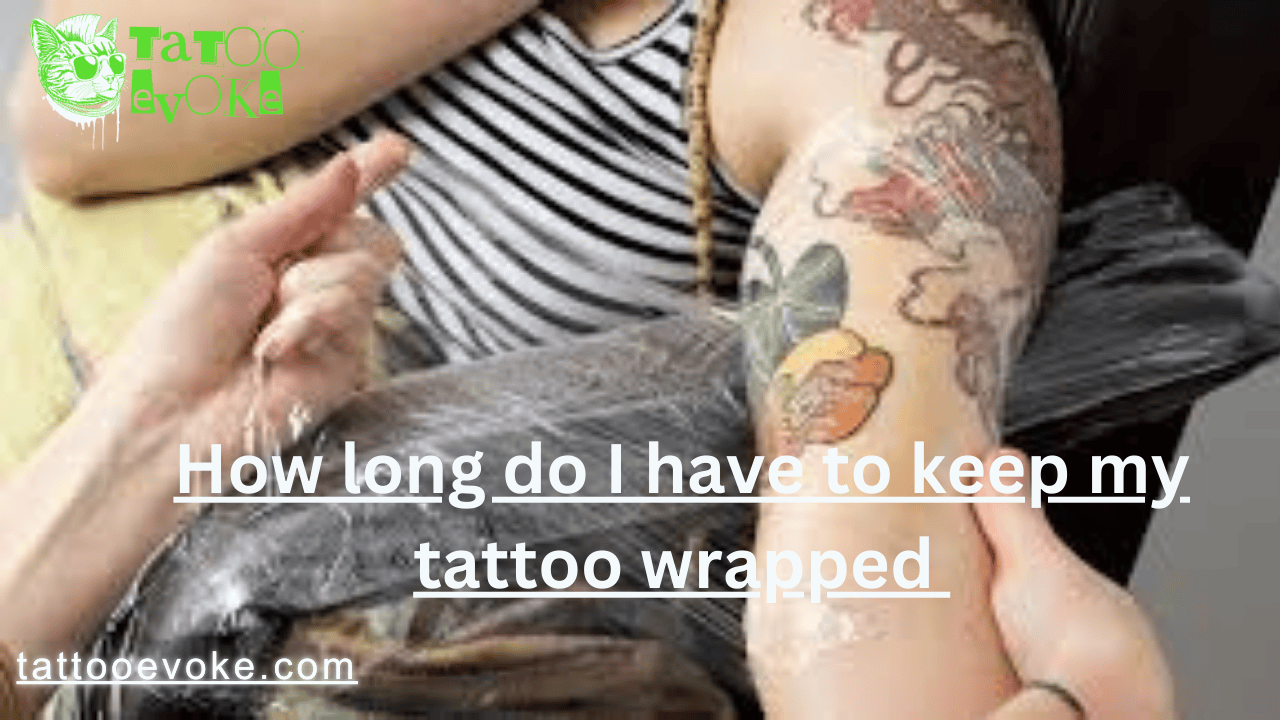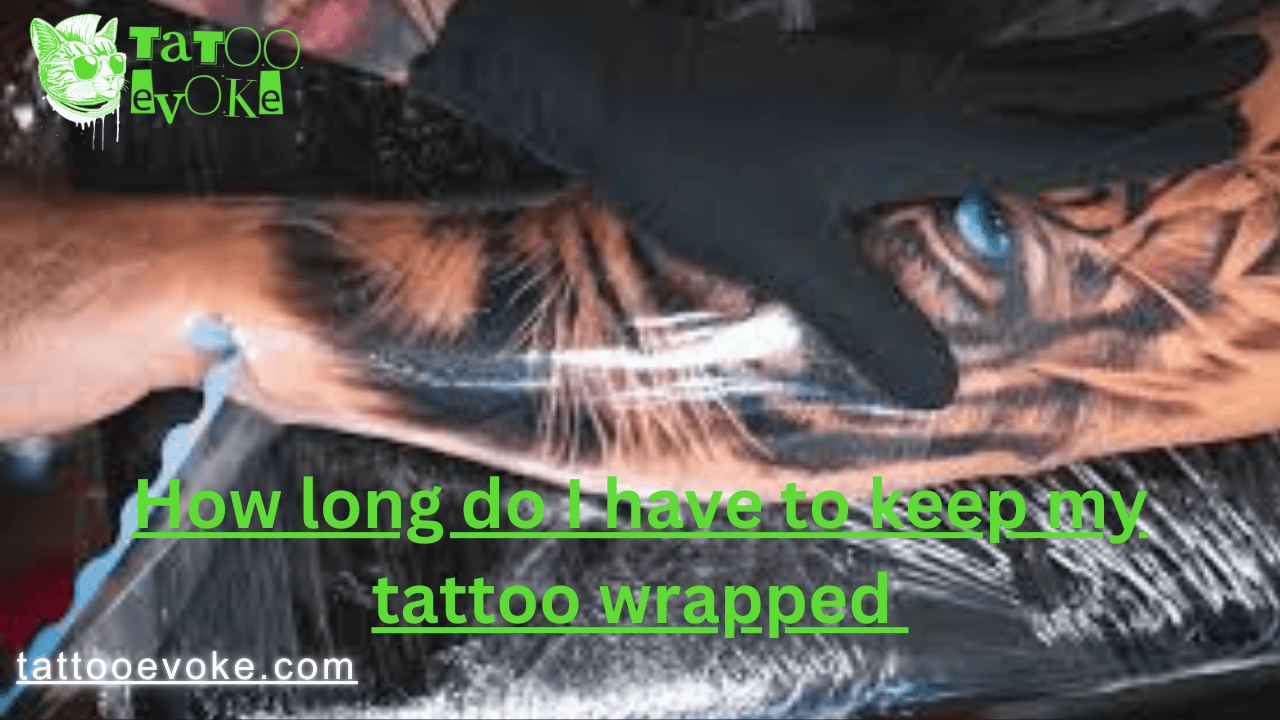Introduction
Getting a new tattoo is super exciting—it’s like wearing your favorite art on your skin! But here’s the thing: taking care of it right after is super important to help it heal well and stay bright/colorful for years. A lot of folks ask their tattoo artist, “How Long to Keep Your Tattoo Wrapped?” The answer? It depends! Your artist will give you specific advice based on the bandage they use and how your skin heals. In this easy-to-follow guide, we’ll explain how long to keep your tattoo covered, how to clean it, avoid problems, and tips to keep your ink looking awesome.
Why Tattoo Wrapping Matters: Shielding Your Fresh Ink

When you leave the studio, your tattoo is essentially an open wound. The wrap acts as a critical shield/barrier against bacteria, dirt, and friction from clothing or surfaces. Most artists use saniderm (a medical-grade adhesive film) or traditional cling wrap to cover the area. Keeping it wrapped for the right amount of time prevents scabbing, fading, and infections, which can ruin your design.
The initial wrap is typically left on for 2–4 hours. This short period allows your skin to start healing/sealing while trapping beneficial plasma that kickstarts recovery. After removing it, gently clean the tattoo with lukewarm water and a mild, fragrance-free soap. Your artist might apply a second bandage/dressing, which you’ll wear for 24–48 hours. Always follow their specific advice—they understand your skin type, ink placement, and the tools used during your session.
Types of Tattoo Wraps: Saniderm vs. Cling Film
Not all wraps are created equal. Let’s compare the two most popular options:
-
Saniderm (Medical-Grade Adhesive Film)This breathable, waterproof wrap is designed to stay on for 3–7 days, depending on your artist’s recommendation. It locks in plasma, creating a moist/healing environment that speeds up recovery. Saniderm reduces scabbing and peeling, making it ideal for large or intricate tattoos. However, if the film leaks, loosens, or causes itching, remove it immediately.
-
Cling Wrap (Plastic wrap): A cheaper, temporary option often used for the first few hours. Unlike saniderm, it’s not breathable, so leaving it on too long can trap sweat/bacteria. Most artists advise removing cling wrap after 2–4 hours, cleaning the tattoo, and letting it air-dry before applying aftercare cream.
Step-by-Step Aftercare: From Day 1 to Full Healing
First 24 Hours: The Critical Window
Your tattoo will ooze plasma, ink, and blood during the first day. This is normal! The wrap absorbs these fluids, creating a moist/healing environment. Avoid touching the area, exposing it to sunlight, or soaking it in water. If you’re using saniderm, keep it on for 3–5 days unless it leaks or irritates your skin. For cling wrap users:
- Remove after 2–4 hours.
- Wash gently with lukewarm water and unscented soap.
- Pat dry with a clean paper towel (avoid fabric towels—they harbor bacteria).
- Let the tattoo air-dry for 15–20 minutes before applying a thin layer of unscented lotion (like Aquaphor or Lubriderm).
Days 2–4: Cleaning and Moisturizing
After removing the wrap, wash your tattoo 2–3 times daily. Use your fingertips—no washcloths or sponges! Over-cleaning can strip natural oils, while under-cleaning risks infection. Key steps:
- Rinse with lukewarm water.
- Apply a dime-sized amount of soap and lather gently.
- Rinse thoroughly.
- Pat dry and apply lotion.
Pro Tip: If your tattoo feels tight/itchy, use a cold compress (never scratch!).
Week 2–4: The Peeling and Itching Phase
Your tattoo will start peeling/flaking—this is part of the healing process! Resist the urge to pick at it, as this can pull out ink and cause patchiness. Continue moisturizing, but avoid overdoing it. Too much lotion can clog pores and lead to pimples or rashes. Wear loose, breathable clothing to minimize friction.
Avoid:
- Swimming pools, oceans, or hot tubs (risk of bacteria).
- Heavy sweating/gym sessions (wait 2–3 weeks).
- Direct sunlight (UV rays fade ink and slow healing).
Month 2–6: Deep Healing and Touch-Ups
While the surface may look healed in 2–4 weeks, deeper skin layers take months to fully recover. During this time, your tattoo might appear dull or cloudy—this is normal! Keep moisturizing and using SPF 30+ sunscreen. If you notice faded spots, schedule a touch-up with your artist.
Common Mistakes: What NOT to Do During Healing
-
Leaving the Wrap On Too Long: Trapped moisture breeds bacteria. Follow your artist’s timeline strictly.
-
Using Harsh Products: Alcohol, hydrogen peroxide, or scented creams can irritate/damage your tattoo. Stick to gentle, fragrance-free options.
-
Picking Scabs or Peeling Skin: This can cause scarring, ink loss, and infections.
-
Ignoring Red Flags: Swelling, pus, extreme redness, or fever? Contact a healthcare professional immediately.
For more information on tattoo-related risks and precautions, refer to the Mayo Clinic’s Tattoos: Understand Risks and Precautions
Expert Tips for Faster, Healthier Healing

-
Stay Hydrated: Water keeps your skin supple and speeds up repair. Aim for 8–10 glasses daily.
-
Eat Nutrient-Rich Foods: Vitamin C (citrus fruits), zinc (nuts), and protein (eggs, fish) support skin health.
-
Avoid Tight Clothing: Friction rubs off ink and irritates healing skin. Opt for loose cotton fabrics.
-
Sleep Smart: For back or chest tattoos, sleep on your side. Use clean sheets and avoid pets in bed.
For more detailed guidance on tattoo aftercare, refer to the Cleveland Clinic’s Tattoo Aftercare Tips From a Dermatologist.
Seasonal Considerations: Summer vs. Winter Healing
-
Summer: Heat and sweat increase infection risks. Keep the tattoo clean/dry, and avoid sun exposure.
-
Winter: Cold air dries out skin. Moisturize more frequently, but don’t overdo it—balance is key.
The Science Behind Tattoo Healing: What Happens Under Your Skin
When you get inked, needles puncture the epidermis (top layer) and deposit ink into the dermis (middle layer). Your body treats this as an injury, triggering inflammation and sending white blood cells to the area. Over weeks, fibroblasts (healing cells) rebuild collagen, sealing the ink into place. Proper wrapping/aftercare ensures this process happens smoothly without scarring or ink loss.
Final Thoughts: Patience Pays Off for Perfect Ink
Knowing how long to keep your tattoo wrapped is just the first step. Consistent aftercare ensures your ink stays vibrant/sharp for decades. Always prioritize hygiene, follow professional advice, and trust the process. Your tattoo is a lifelong investment—treat it with care!
For more aftercare tips, check out Tattoo Health or consult your artist.
By following this guide, you’ll keep your tattoo looking fresh and radiant while avoiding common pitfalls. Remember, every body heals differently—stay patient, listen to your skin, and enjoy your new art!
FAQs
Q1: How long should I keep my tattoo wrapped after getting it?
A1: Typically, you should keep the initial wrap on for 2–4 hours. However, if your artist uses a medical-grade adhesive film like Saniderm, it may be left on for 3–5 days. Always follow your tattoo artist's specific aftercare instructions.
Q2: What is the best way to clean a new tattoo?
A2: Gently wash your tattoo with lukewarm water and a mild, fragrance-free soap. Pat it dry with a clean paper towel and apply a thin layer of unscented lotion to keep it moisturized.
Q3: Can I exercise after getting a new tattoo?
A3: It's advisable to avoid heavy sweating and intense workouts for at least 2–3 weeks post-tattoo to prevent irritation and infection.
Q4: When can I expose my new tattoo to the sun?
A4: Avoid direct sunlight on your new tattoo for at least 3–4 weeks. Once healed, apply a high-SPF sunscreen to protect the tattoo from fading.
Explore More: Related Articles
